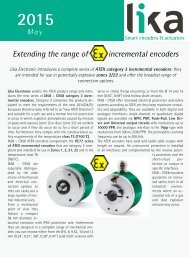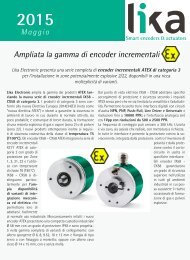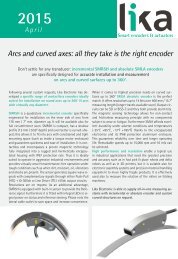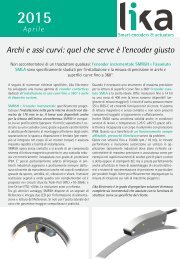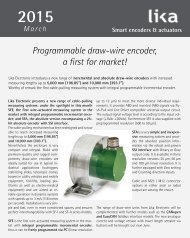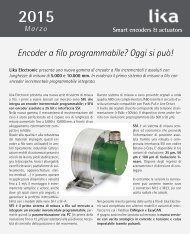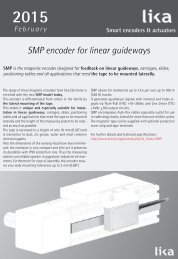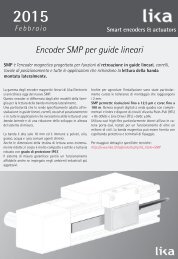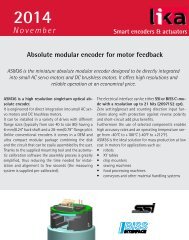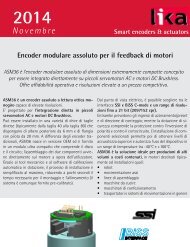LINEPULS & LINECOD catalogue 2016 in English
Lika Electronic incremental and absolute linear encoders catalogue 2016 in English Our new linear encoders catalogue is out now, and features many innovative new products and up-to-date information. The catalogue is expressly designed to set out the comprehensive range of incremental & absolute linear encoders from Lika Electronic. Check it out, it is completely renewed! Make sure you don’t miss out on a copy, download the pdf file from our web site or request your hard copy now! We have also got an interactive digital version in the works that shall be released soon!
Lika Electronic incremental and absolute linear encoders catalogue 2016 in English
Our new linear encoders catalogue is out now, and features many innovative new products and up-to-date information. The catalogue is expressly designed to set out the comprehensive range of incremental & absolute linear encoders from Lika Electronic. Check it out, it is completely renewed!
Make sure you don’t miss out on a copy, download the pdf file from our web site or request your hard copy now!
We have also got an interactive digital version in the works that shall be released soon!
Create successful ePaper yourself
Turn your PDF publications into a flip-book with our unique Google optimized e-Paper software.
<strong>LINEPULS</strong> • <strong>LINECOD</strong><br />
Technical <strong>in</strong>formation<br />
www.lika.biz<br />
L<strong>in</strong>ear sensors are equipped with high-flex cables especially suited for use <strong>in</strong> cable drag<br />
cha<strong>in</strong>s and tested for more than 1 million cycles. Furthermore they are expressly designed for<br />
high speeds up to 10 m/s and accelerations up to 6 m/s 2 . They are halogen free and resistant<br />
to oil, hydrolysis and abrasion. For more details please refer to page 118.<br />
When choos<strong>in</strong>g an encoder model, please consider the noise and the cable length that could<br />
affect the system and reduce its performances. Longer cable lengths are more susceptible to<br />
noise. It is crucial to use proper cable lengths to ensure that the system operates correctly.<br />
We recommend shielded, twisted-pair cables to be used. For more <strong>in</strong>formation on the cable<br />
lengths recommended for each <strong>in</strong>terface please refer to the specific sections.<br />
Cables<br />
The magnetic tape is magnetized <strong>in</strong> order to have a sequence of North and South poles<br />
along the path. The poles allow the magnetic sensor pass<strong>in</strong>g along the tape to detect the<br />
changes <strong>in</strong> the magnetic field, that is to sense each small shift <strong>in</strong> the position and so to<br />
output a signal <strong>in</strong> response to motion.<br />
The pole pitch is the distance between two consecutive poles and is expressed <strong>in</strong> millimetres.<br />
Pole pitch<br />
In an <strong>in</strong>cremental measur<strong>in</strong>g system the tape has a systematic sequence of North and<br />
South poles. The pole pitch depends on the magnetization process and tapes with a variety<br />
of pole pitches can be supplied. MT10 magnetic tape, for <strong>in</strong>stance, provides 1.0-mm pole<br />
pitches, while MTS25 magnetic tape provides 2.5-mm pole pitches. The smaller the pole<br />
pitch, the higher the resolution and the quality of the positional <strong>in</strong>formation.<br />
The <strong>in</strong>cremental pole pitches can be 1, 2, 2.5, 3.2, 4 and 5 mm long, accord<strong>in</strong>g to models.<br />
In an absolute measur<strong>in</strong>g system, the absolute cod<strong>in</strong>g pole pitch depends on the physical<br />
characteristics of the sensor array deployed <strong>in</strong> the sens<strong>in</strong>g head. The smaller is the distance<br />
between the sensors <strong>in</strong> the array, the smaller is the pole pitch. In an absolute measur<strong>in</strong>g<br />
system the tape has a sequence of alternat<strong>in</strong>g magnetic fields, but they have different dimensions<br />
(more than one either North or South pole could follow <strong>in</strong> the sequence).<br />
You must always pair the encoder with the right pole pitch tape.<br />
For <strong>in</strong>stance, the SME1 l<strong>in</strong>ear encoder must be compulsorily paired with the MT10 tape.<br />
If otherwise, the sensor cannot work.<br />
The resolution can be def<strong>in</strong>ed <strong>in</strong> several<br />
ways. It is the ability to provide the <strong>in</strong>formation<br />
over a def<strong>in</strong>ed space; otherwise<br />
it is the spac<strong>in</strong>g between two consecutive<br />
discrete po<strong>in</strong>ts, i.e. the sequence of<br />
<strong>in</strong>formation. The more discrete po<strong>in</strong>ts are<br />
used and the smaller the distance between<br />
these po<strong>in</strong>ts, the higher will be the resolution<br />
of the measurement system and the<br />
quality of its <strong>in</strong>formation.<br />
When referr<strong>in</strong>g to an <strong>in</strong>cremental l<strong>in</strong>ear<br />
encoder, the resolution (otherwise referred<br />
to as “measur<strong>in</strong>g step” or “measur<strong>in</strong>g<br />
<strong>in</strong>crement”) is the distance between two<br />
follow<strong>in</strong>g edges of A and B channels. It results<br />
from the pole pitch of the magnetic<br />
tape and the <strong>in</strong>terpolation factor. It is <strong>in</strong>dicated<br />
by us<strong>in</strong>g a metric length such as<br />
millimetres (mm) or microns (μm). Digital<br />
l<strong>in</strong>ear <strong>in</strong>cremental encoders <strong>in</strong>terpolate the<br />
analogue s<strong>in</strong>e/cos<strong>in</strong>e signals by an <strong>in</strong>terpolation factor <strong>in</strong> order to sub-divide the tape period,<br />
so provid<strong>in</strong>g a higher measurement resolution. The output of the <strong>in</strong>terpolation process<br />
results <strong>in</strong> quadrature squarewaves – the distance between the edges of the A and B channels<br />
be<strong>in</strong>g the resolution of the encoder. Unlike what is stated <strong>in</strong> rotary encoders, the resolution<br />
<strong>in</strong>dicated <strong>in</strong> this <strong>catalogue</strong> for the l<strong>in</strong>ear <strong>in</strong>cremental encoders is always to be <strong>in</strong>tended<br />
after quadruplication, as shown <strong>in</strong> the Figure.<br />
Resolution<br />
In an absolute encoder the resolution can be def<strong>in</strong>ed as the smallest change <strong>in</strong> the underly<strong>in</strong>g<br />
physical quantity that produces a response <strong>in</strong> the measurement, the response be<strong>in</strong>g<br />
the absolute <strong>in</strong>formation that is provided to output.<br />
13




